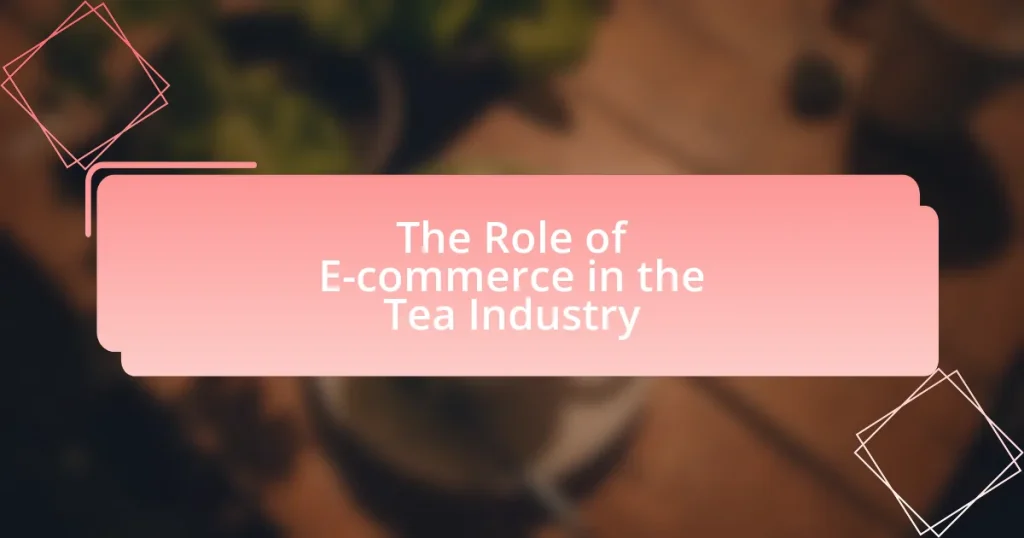E-commerce is transforming the tea industry by facilitating direct sales between producers and consumers, enhancing market access, and reducing distribution costs. This digital platform allows small-scale tea farmers to reach a global audience, significantly increasing their visibility and sales potential. Key features of e-commerce platforms, such as user-friendly interfaces and secure payment systems, improve customer experience and engagement. However, tea businesses face challenges including intense competition and supply chain complexities. The article explores the advantages of e-commerce for tea producers, the impact of consumer behavior on purchasing decisions, and future trends shaping the industry, emphasizing the importance of effective strategies for success in this evolving market.

What is the Role of E-commerce in the Tea Industry?
E-commerce plays a crucial role in the tea industry by facilitating direct sales between producers and consumers, thereby increasing market access and reducing distribution costs. This digital platform allows tea producers, especially small-scale farmers, to reach a global audience, enhancing their visibility and sales potential. According to a report by Research and Markets, the global online tea market is projected to grow significantly, driven by the increasing preference for online shopping and the convenience it offers. Furthermore, e-commerce enables tea brands to engage with customers through targeted marketing and personalized experiences, which can lead to higher customer loyalty and repeat purchases.
How has e-commerce transformed the tea industry?
E-commerce has transformed the tea industry by enabling direct-to-consumer sales, which increases accessibility and market reach for tea producers. This shift allows small and artisanal tea brands to compete with larger companies by selling their products online, thus expanding their customer base beyond local markets. According to a report by Statista, global e-commerce sales in the food and beverage sector, which includes tea, reached approximately $1 trillion in 2021, highlighting the significant growth potential for tea businesses leveraging online platforms. Additionally, e-commerce facilitates better consumer engagement through personalized marketing and customer feedback, further enhancing brand loyalty and sales.
What are the key features of e-commerce platforms for tea sales?
The key features of e-commerce platforms for tea sales include user-friendly interfaces, secure payment gateways, inventory management systems, and customer review functionalities. User-friendly interfaces enhance customer experience by allowing easy navigation and product discovery, which is crucial for retaining customers in a competitive market. Secure payment gateways ensure safe transactions, which is vital as online shopping increases. Inventory management systems help sellers track stock levels and manage orders efficiently, reducing the risk of overselling or stockouts. Customer review functionalities enable buyers to share their experiences, fostering trust and influencing purchasing decisions. These features collectively enhance operational efficiency and customer satisfaction in the tea sales sector.
How do e-commerce platforms enhance customer experience in the tea industry?
E-commerce platforms enhance customer experience in the tea industry by providing convenient access to a diverse range of products, personalized recommendations, and seamless purchasing processes. These platforms allow consumers to explore various tea types, brands, and flavors from the comfort of their homes, significantly increasing product availability compared to traditional retail. Additionally, many e-commerce sites utilize algorithms to analyze customer preferences and browsing history, offering tailored suggestions that improve the shopping experience. According to a report by Statista, 70% of consumers are more likely to purchase from a site that offers personalized experiences. Furthermore, e-commerce platforms often feature user reviews and ratings, which help customers make informed decisions, thereby increasing satisfaction and trust in their purchases.
What are the advantages of e-commerce for tea producers?
E-commerce provides tea producers with increased market reach, allowing them to sell directly to consumers globally. This direct-to-consumer model reduces reliance on traditional distribution channels, which can be costly and limit access to broader markets. According to a report by Statista, global e-commerce sales are projected to reach $6.54 trillion by 2022, indicating a significant opportunity for tea producers to tap into this growing market. Additionally, e-commerce platforms enable tea producers to showcase their products through detailed descriptions and customer reviews, enhancing consumer trust and engagement. This digital presence can lead to higher sales volumes and improved brand recognition in a competitive industry.
How does e-commerce expand market reach for tea producers?
E-commerce expands market reach for tea producers by enabling them to sell directly to consumers globally, bypassing traditional distribution channels. This direct-to-consumer model allows tea producers to access a wider audience, including niche markets that may not be reachable through physical retail outlets. For instance, a study by Statista indicates that global e-commerce sales are projected to reach $6.54 trillion by 2022, highlighting the significant potential for tea producers to tap into this growing market. Additionally, platforms like Amazon and specialized tea websites provide tea producers with the tools to showcase their products, engage with customers, and build brand loyalty, further enhancing their market presence.
What cost savings can tea producers achieve through e-commerce?
Tea producers can achieve significant cost savings through e-commerce by reducing operational expenses associated with traditional retail channels. E-commerce eliminates the need for physical storefronts, which can incur high rent and maintenance costs. Additionally, online platforms streamline inventory management and logistics, leading to lower shipping and handling expenses. A study by the International Trade Centre found that businesses utilizing e-commerce can reduce costs by up to 30% compared to traditional sales methods. This reduction in overhead allows tea producers to allocate resources more efficiently, ultimately enhancing their profit margins.
What challenges do tea businesses face in e-commerce?
Tea businesses face several challenges in e-commerce, including intense competition, supply chain complexities, and customer trust issues. The e-commerce landscape is crowded with numerous brands, making it difficult for tea businesses to differentiate themselves and capture market share. Additionally, managing the supply chain for perishable goods like tea can be complicated, as it requires efficient logistics to maintain product quality and freshness during shipping. Furthermore, building customer trust is crucial, as consumers often hesitate to purchase food products online without prior experience or reliable reviews. These challenges are supported by industry reports indicating that 70% of consumers prefer to buy food products from brands they know, highlighting the importance of brand recognition and trust in e-commerce.
How do logistics and supply chain issues affect e-commerce in the tea industry?
Logistics and supply chain issues significantly hinder e-commerce in the tea industry by causing delays, increasing costs, and affecting product quality. For instance, disruptions in transportation can lead to late deliveries, which negatively impact customer satisfaction and sales. Additionally, inefficiencies in inventory management can result in stockouts or overstock situations, complicating order fulfillment. According to a report by the World Bank, supply chain disruptions can increase operational costs by up to 30%, directly affecting profit margins for tea e-commerce businesses. Furthermore, quality degradation during transportation can lead to customer complaints and returns, further straining e-commerce operations.
What are the common technological barriers for tea businesses in e-commerce?
Common technological barriers for tea businesses in e-commerce include inadequate digital infrastructure, limited access to reliable internet, and lack of technical expertise. Inadequate digital infrastructure hampers the ability to create and maintain effective online platforms, which is crucial for reaching customers. Limited access to reliable internet affects the ability to conduct transactions and manage online operations efficiently. Additionally, a lack of technical expertise among staff can lead to difficulties in utilizing e-commerce tools and platforms effectively, resulting in lost sales opportunities. These barriers collectively hinder the growth and competitiveness of tea businesses in the e-commerce landscape.
How does consumer behavior influence e-commerce in the tea industry?
Consumer behavior significantly influences e-commerce in the tea industry by shaping purchasing decisions, preferences, and brand loyalty. For instance, the increasing trend of health consciousness among consumers has led to a higher demand for organic and specialty teas, prompting e-commerce platforms to stock these products prominently. According to a report by Grand View Research, the global organic tea market is expected to reach $3.5 billion by 2025, driven by consumer preferences for healthier options. Additionally, online reviews and social media influence consumer perceptions and trust, which directly impacts sales on e-commerce platforms. A survey by BrightLocal found that 91% of consumers read online reviews, indicating that positive feedback can enhance brand reputation and drive e-commerce growth in the tea sector.
What trends are shaping online tea purchasing decisions?
Growing consumer interest in health and wellness is significantly shaping online tea purchasing decisions. This trend is evidenced by a surge in demand for herbal and specialty teas that offer health benefits, such as antioxidants and stress relief. According to a report by Grand View Research, the global herbal tea market is expected to reach $4.5 billion by 2027, indicating a strong consumer preference for health-oriented products. Additionally, the rise of e-commerce platforms has facilitated access to a wider variety of teas, allowing consumers to explore niche brands and products that align with their health goals. The convenience of online shopping, combined with the ability to read reviews and compare products, further influences purchasing behavior, as consumers seek quality and transparency in their tea choices.
How do customer reviews impact e-commerce sales in the tea sector?
Customer reviews significantly influence e-commerce sales in the tea sector by enhancing consumer trust and driving purchasing decisions. Research indicates that 79% of consumers trust online reviews as much as personal recommendations, which is crucial in the tea market where product quality and flavor are paramount. Positive reviews can lead to increased sales, as they often result in higher visibility on e-commerce platforms due to algorithms favoring well-reviewed products. Conversely, negative reviews can deter potential buyers, leading to decreased sales and a damaged brand reputation. In summary, customer reviews serve as a vital component in shaping consumer perceptions and ultimately impact sales performance in the tea sector.
What strategies can tea businesses implement for successful e-commerce?
Tea businesses can implement several strategies for successful e-commerce, including optimizing their websites for user experience, utilizing social media marketing, and offering subscription services. Optimizing websites involves ensuring fast loading times, mobile responsiveness, and easy navigation, which can lead to higher conversion rates; studies show that 53% of mobile users abandon sites that take over three seconds to load. Social media marketing allows tea businesses to engage with customers, showcase products, and drive traffic to their online stores, as 73% of marketers believe that their efforts through social media marketing have been effective for their business. Additionally, offering subscription services can create a steady revenue stream and enhance customer loyalty, with subscription box services in various industries experiencing a growth rate of over 100% annually. These strategies collectively enhance visibility, customer engagement, and sales in the competitive e-commerce landscape of the tea industry.
How can tea brands effectively utilize social media for e-commerce?
Tea brands can effectively utilize social media for e-commerce by engaging their audience through targeted content, interactive campaigns, and influencer partnerships. By creating visually appealing posts that showcase their products, brands can attract potential customers and drive traffic to their online stores. For instance, using platforms like Instagram and Facebook, tea brands can share brewing tips, health benefits, and user-generated content to foster community engagement. Additionally, running promotions or contests can incentivize sharing and increase brand visibility. Research indicates that 54% of social media users browse products on these platforms, highlighting the importance of a strong social media presence for driving e-commerce sales in the tea industry.
What role does SEO play in enhancing e-commerce visibility for tea products?
SEO significantly enhances e-commerce visibility for tea products by optimizing online content to rank higher in search engine results. This optimization involves using relevant keywords, improving website structure, and enhancing user experience, which collectively increase organic traffic to e-commerce sites. For instance, a study by HubSpot found that 75% of users never scroll past the first page of search results, highlighting the importance of SEO in capturing potential customers’ attention. By effectively implementing SEO strategies, tea brands can attract more visitors, leading to higher sales and brand recognition in a competitive market.
What future trends can we expect in e-commerce for the tea industry?
Future trends in e-commerce for the tea industry include increased personalization, sustainability initiatives, and the integration of advanced technologies like AI and AR. Personalization will enhance customer experiences through tailored recommendations based on purchasing behavior, which studies show can increase sales by up to 20%. Sustainability initiatives will focus on eco-friendly packaging and sourcing, responding to consumer demand for environmentally responsible products, as evidenced by a 2022 survey indicating that 73% of consumers prefer brands that prioritize sustainability. Additionally, the use of AI for inventory management and AR for virtual tea tastings will streamline operations and engage customers more effectively, aligning with the growing trend of digital interaction in retail.
How will technology advancements shape the future of tea e-commerce?
Technology advancements will significantly shape the future of tea e-commerce by enhancing user experience, improving supply chain efficiency, and enabling personalized marketing. Innovations such as artificial intelligence and machine learning will allow for better customer insights, leading to tailored recommendations and improved customer satisfaction. For instance, AI-driven chatbots can provide instant customer support, while data analytics can optimize inventory management, reducing waste and ensuring product availability. Additionally, advancements in mobile payment systems and augmented reality can create seamless shopping experiences, allowing consumers to visualize products before purchase. According to a report by Statista, the global e-commerce market is projected to reach $6.54 trillion by 2022, indicating a growing trend that tea e-commerce can leverage through these technological improvements.
What emerging markets are likely to influence e-commerce in the tea industry?
India and China are emerging markets likely to significantly influence e-commerce in the tea industry. Both countries have large populations with increasing internet penetration and a growing middle class that is driving demand for premium tea products. According to a report by Statista, the e-commerce market in India is projected to reach $200 billion by 2026, which includes a substantial segment for food and beverages like tea. Additionally, China’s online retail sales of food and beverages reached approximately $100 billion in 2021, indicating a robust market for tea e-commerce. These factors position India and China as key players in shaping the future of e-commerce in the tea sector.
What best practices should tea businesses follow for e-commerce success?
Tea businesses should prioritize user-friendly website design, effective digital marketing strategies, and high-quality product presentation for e-commerce success. A user-friendly website enhances customer experience, leading to higher conversion rates; studies show that 38% of users will stop engaging with a website if the content or layout is unattractive. Effective digital marketing, including SEO and social media engagement, increases visibility and attracts targeted customers, as 70% of consumers prefer to learn about products through content rather than traditional advertising. High-quality product presentation, including detailed descriptions and professional images, builds trust and encourages purchases, with 93% of consumers considering visual appearance as a key factor in their buying decisions.


